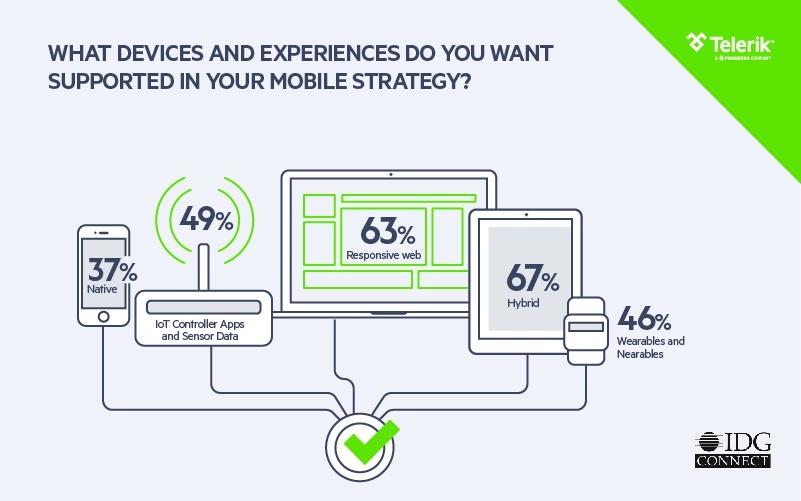Booming Mobile Development Presents Challenges to Businesses

Mobile apps are desired more and more by users everywhere, but keeping up with the rapid pace of mobile development can be a challenge for businesses. In our survey we explore the biggest challenges IT organizations face today.
Is it going to be raining tomorrow? Where’s the nearest Starbucks? Is your flight on time? How is the stock market doing today?
Chances are, you turn to your phone to get answers to these and many other questions every day. Everywhere you look, you see people using mobile devices such as smartphones and tablets. Technology has become an extension of the human brain; we use smartphones to take notes, store memories, get directions, pay our bills and perform many other daily tasks.
Moreover, mobile has become more than just a means to access information and carry out those tasks. In fact, mobile has been the preferred method of engagement for the majority of the consumers since 2014. According to the 2015 KPCB report, 51 percent of the total time spent online is on mobile devices, as opposed to the 42% of time on desktop.

This shift in consumer behavior has led to change across all industries. Numerous mobile-only or mobile-first innovations are shaking the fundamentals of the status quo.
For example, Uber has leveraged this shift to disrupt the monopoly of taxi cab transportation by reinventing the experience. Whereas hailing a cab can be difficult or slow in certain areas or late at night, Uber and Lyft make getting from A to B a fast, hassle-free experience, anywhere, any time. Taxi companies have been too slow to adapt, and look what’s happening: in the beginning of 2016, only a few years after Uber and Lyft made their way into the mainstream, San Francisco’s largest taxi company, Yellow Cab Co-Op, filed for chapter 11 bankruptcy.
Similar disruptions are beginning to occur across all industries, and businesses are taking note: to stay relevant in today today’s changing technology landscape, mobile is a must. Those incapable of leveraging technological innovation to respond to the shift in consumer behavior are destined for irrelevance. Most businesses realize the importance of mobile innovation and are trying to catch up; however, many larger businesses are finding it difficult to keep pace with their legacy IT infrastructure and processes.
The Biggest Challenges Facing IT Organizations
What are the biggest challenges IT organizations face today? To answer that question, Telerik has partnered with IDG Connect to survey more than 150 IT decision makers, and gain insights into how organizations in Europe and the U.S. currently approach mobile app development. We’ve also tried to gather opinions on what changes to the project lifecycle management process can provide a competitive advantage. Following are the key findings.
Mobile App Development Is Booming
Eighty percent plan five or more mobile app development projects over the next 12 months.
User Experience Is Top of Mind
The cost of a bad user experience is high. Mobile apps are considered unlikely to achieve widespread adoption or enhance the reputation of the company distributing them, unless they provide an interface that’s functional, simple to navigate and easy to understand.
Success Is Challenging
Security, limited resources and meeting business requirements are some of the biggest challenges.
The Development Approach Depends on the Project
A broad mix of hybrid, responsive web and native mobile apps appear destined for a diverse array of hardware platforms, such as smartphones, tablets, notebook computers, wearable devices, Internet of Things (IoT) sensors and embedded components.

Cross-Platform Development Enables Platform Diversity
Hybrid and responsive web design are the most-favored approaches to mobile app development. Seventy-five percent of organizations take more than three months to plan, build and deliver mobile apps from scratch, and half feel that additional resources are required to meet their mobile app development needs. Cross-platform mobile app development solutions are seen as a way to streamline app development.
To learn more about mobile app development challenges, read our findings in more depth.
You can also learn more about our own cross-platform mobile development solution, the Telerik Platform, by clicking below.

Ruslan Mursalzade
Ruslan Mursalzade (@RuslanML) is a techie who is passionate about all things design, technology, entrepreneurship, software, and electronics. Ruslan works for Telerik as a Product Marketing Manager based out of San Francisco Bay Area and strives to deliver game-changing products to customers.
